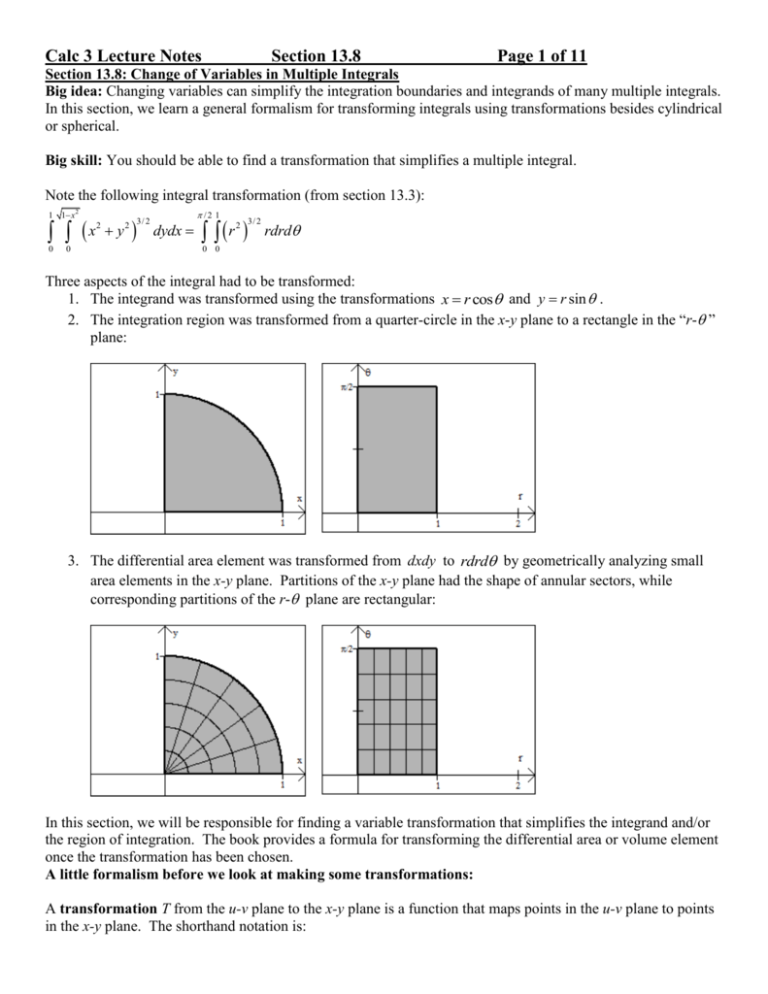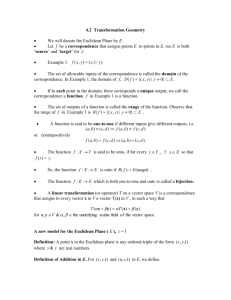Change of Variables in Multiple Integrals
advertisement

Calc 3 Lecture Notes Section 13.8 Page 1 of 11 Section 13.8: Change of Variables in Multiple Integrals Big idea: Changing variables can simplify the integration boundaries and integrands of many multiple integrals. In this section, we learn a general formalism for transforming integrals using transformations besides cylindrical or spherical. Big skill: You should be able to find a transformation that simplifies a multiple integral. Note the following integral transformation (from section 13.3): 1 1 x2 0 0 x2 y 2 3/ 2 /2 1 dydx r 2 3/ 2 rdrd 0 0 Three aspects of the integral had to be transformed: 1. The integrand was transformed using the transformations x r cos and y r sin . 2. The integration region was transformed from a quarter-circle in the x-y plane to a rectangle in the “r- ” plane: 3. The differential area element was transformed from dxdy to rdrd by geometrically analyzing small area elements in the x-y plane. Partitions of the x-y plane had the shape of annular sectors, while corresponding partitions of the r- plane are rectangular: In this section, we will be responsible for finding a variable transformation that simplifies the integrand and/or the region of integration. The book provides a formula for transforming the differential area or volume element once the transformation has been chosen. A little formalism before we look at making some transformations: A transformation T from the u-v plane to the x-y plane is a function that maps points in the u-v plane to points in the x-y plane. The shorthand notation is: Calc 3 Lecture Notes T u, v x, y Section 13.8 Page 2 of 11 where x g u, v and y h u, v for some functions g and h. A change of variables for a double integral is defined by a transformation T from a region S in the u-v plane to a region R in the x-y plane. R is called the image of S under the transformation T. T is one-to-one on S if for every point (x, y) in R there is exactly one point (u, v) in S such that T(u, v) = (x, y). o This implies we can solve for u and v in terms of x and y. Also, we will restrict our transformations to those where g and h have continuous first partial derivatives in S. Calc 3 Lecture Notes Section 13.8 Page 3 of 11 Practice: 1. Let R be the region bounded by the lines y 2 x , y 2 x 4 , y 0.5 x , and y 0.5 x 2 . Find a transformation T that maps a rectangular region in the u-v plane onto this parallelogram. Notice that you can show that the intersection points are (0, 0), (4/3, 8/3), (4, 4), and (8/3, 4/3). Show how the boundaries of a double integral are simplified by the transformation. Calc 3 Lecture Notes Section 13.8 Page 4 of 11 1 2 1 Let R be the region bounded by the hyperbolae y and y and the lines y 2 x and y x . Find a x x 2 transformation T that maps a rectangular region in the u-v plane. Show how the boundaries of a double integral are simplified by the transformation. Calc 3 Lecture Notes Section 13.8 Page 5 of 11 Now that we’ve had some practice finding transformations, let’s derive a formula for computing the differential area element given a transformation. First suppose that we have a transformation from (u, v) onto (x, y). Under this transformation, rectangular partitions of the region S will transform to non-rectangular partitions of the region R. The problem is, we need the areas Ai of each of the curvilinear regions Ri, because those areas are used in computing double integrals: R n f x, y dA f xi , yi Ai i 1 The trick is to approximate each Ai as a parallelogram whose four corners come from the transformed coordinates of the rectilinear regions Si: The points A, B, C, and D have coordinates determined by the transformation T: A xi , yi g ui , vi , h ui , vi B g ui u , vi , h ui u , vi C g ui u , vi v , h ui u , vi v D g ui , vi v , h ui , vi v Calc 3 Lecture Notes Section 13.8 Page 6 of 11 These coordinates can be used to compute the vectors AB and AD . We want these vectors because the area of the parallelogram they describe can be computed using AB AD . AB g ui u , vi g ui , vi , h ui u , vi h ui , vi AD g ui , vi v g ui , vi , h ui , vi v h ui , vi From the definition of partial derivatives, So, for u and v small, g ui u, vi g ui , vi g . ui , vi lim u 0 u u g ui , vi u u h h ui u, vi h ui , vi ui , vi u u g g ui , vi v g ui , vi ui , vi v v h h ui , vi v h ui , vi ui , vi v v g ui u, vi g ui , vi So, our vectors simplify to: g h AB ui , vi , ui , vi u u u g h AD ui , vi , ui , vi v v v And now we can compute the cross section: i j k g h ui , vi u ui , vi u 0 u u g h ui , vi v ui , vi v 0 v v g h ui , vi ui , vi u u u vk g h ui , vi ui , vi v v AB AD And now we can compute area: g h ui , vi ui , vi u u Ai AB AD uv g h ui , vi ui , vi v v g g ui , vi ui , vi u v uv h h ui , vi ui , vi u v x x ui , vi ui , vi u v uv y y ui , vi ui , vi u v Calc 3 Lecture Notes Section 13.8 Page 7 of 11 Definition 8.1: Jacobian of a Transformation The determinant x x u v y y u v is called the Jacobian of a transformation T and is written using the notation x, y u, v Given this area transformation and definition, we can convert our integral to the u-v plane: n f x, y dA f xi , yi Ai i 1 R n f xi , yi i 1 x, y u v u, v n f g ui , vi , h ui , vi i 1 f g u , v , h u , v S x, y u, v x, y u, v u v dudv Theorem 8.1: Change of Variables in Double Integrals If a region S in the u-v plane is mapped onto the region R in the x-y plane by the one-to-one transformation T defined by x g u, v and y h u, v , where g and h have continuous first derivatives on S, and if f is continuous on R and the Jacobian R x, y u, v f x, y dA f g u , v , h u , v S is nonzero on S, then x, y u, v dudv . Calc 3 Lecture Notes Section 13.8 Page 8 of 11 Practice: 2. Show that the Jacobian yields the correct differential area element dA for polar coordinates. 3. Compute the Jacobian for the hyperbolic transformation from page 4. Calc 3 Lecture Notes 4. Compute Section 13.8 Page 9 of 11 8 x 2 y dA for the region R shown below first using Cartesian coordinates and then R using transformed coordinates. Calc 3 Lecture Notes Section 13.8 Page 10 of 11 Change of variables for triple integrals: In three dimensions, a change of variables is fairly analogous to the two dimensional case: Given a transformation T from a region S of u-v-w space onto a region R of x-y-z space, specified by the functions x g u, v, w , y h u, v, w , and z u, v, w , the Jacobian is defined as: x x x u v w x, y, z y y y u , v, w u v w z z z u v w Theorem 8.2: Change of Variables in Triple Integrals If a region S in u-v-w space is mapped onto the region R in x-y-z space by the one-to-one transformation T defined by x g u, v, w , y h u, v, w , and z u, v, w , where g, h, and have continuous first derivatives on S, and if f is continuous on R and the Jacobian R x, y , z u , v, w f x, y, z dV f g u , v, w , h u , v, w , S is nonzero on S, then u , v, w x, y , z u , v, w dudvdw . Practice: 5. Show that the Jacobian yields the correct differential volume element dV for spherical coordinates. Calc 3 Lecture Notes Section 13.8 Page 11 of 11 6. Toroidal coordinates are used to specify the location of points inside toroids as shown below. The center of the toroid is a circle of radius a (called the major radius) in the x-y plane, and points are located by an angle measured from the standard position in the x-y plane, a distance r measured from the major circle, and an angle measured in the plane = k. The transformation is specified by: x a r cos cos y a r cos sin z r sin Compute the volume of a torus with a major radius of 2 and a minor radius of 1. Compare this to the answer you get from Pappus’ Second Theorem, which says that the volume of a solid of revolution equals the cross-sectional area of the rotated lamina times the distance the traveled by its centroid.









